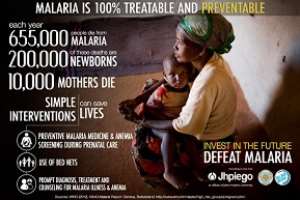
Malaria is a disease different from Acquired Immune Deficiency Syndrome-AIDS, but both have something in common, they don’t discriminate.
Malaria has been a long time tropical disease that has ravaged the African continent before the white explorers landed on the shores of Africa. It took many of them to their untimely grave; hence they referred the continent to ‘The white man’s grave.’
Despite the amazing discovery of technology, healthcare improvement, and vaccines, malaria continues to kill hundreds of children and adults every year in Africa.
The sickness is caused by a single-cell parasite called Plasmodium. Anopheles mosquitoes, usually females pick up the parasite from infected people when they bite. After biting, the blood they obtained nurtures their eggs.
Inside the mosquito, the parasites develop and reproduce. When the mosquito bites again, the parasites mix with its saliva and pass into the blood of the person being bitten.
Africa’s fragile health care system and poverty have caused widespread of the disease at a faster rate like the Acquired Immune Deficiency Syndrome (AIDS). Other factors which have escalated malaria in Africa, is the poor drainage system.
Waste disposal, recycling, and poor drainage systems remain a key challenge facing every city in Africa. Stagnant pools choked gutters and marshy places later become a breeding ground for mosquitoes where they lay their eggs.
A malaria victim may show no symptoms for weeks after bitten by mosquitoes until the parasites return to the bloodstream and invade the red blood cells.
Rapid multiplication of the parasites ruptures the red cells, releasing more parasites into the bloodstream and causing the characteristic symptoms.
If the person does not receive prompt and effective drug therapy, damage may occur to the brain and other organs, sometimes leading to death.
In many parts of Africa, where a sick person goes to the hospital if only he can afford, a malaria victim has no chance to recover than to succumb to the disease.
The victim loses appetite, preventing the desire to eat. Weak and confined permanently to bed, malaria victim sleeps for hours. At times the victim sweats profusely and efforts to sleep become a nightmare.
Malaria statistics indicate that over half a million (655, 000) people die from malaria each year, mostly children younger than five years old.
There are an estimated 216 million cases of malaria each year. Although the vast majority of malaria cases occur in sub-Saharan Africa, the disease is a public-health problem in more than 109 countries in the world, 45 of which are in Africa.
Approximately 3.3 billion people live in areas where malaria is a constant threat. 90% of all malaria deaths occur in sub-Saharan Africa.

Poor drainage, stagnant water, and filthy environments are common breeding grounds for mosquitoes
Malaria eradication has been on the discussion table for years but still remains an illusion, since poverty is the source of all diseases in Africa.
However, measures are applied to control the disease. Bed nets, domestic spraying insecticides, spraying infected places with DDT and anti-malaria vaccine help to protect people and the environment from malaria.
However; until the African government finds a solution to its waste disposal problems and poor underground drainage systems, the possibility of eliminating or reducing malaria in the continent of Africa will be a dream of illusion.




 We’ll protect state wealth from opaque deals – Prof Jane Naana
We’ll protect state wealth from opaque deals – Prof Jane Naana
 Mauritania president says running for second term in June polls
Mauritania president says running for second term in June polls
 I won't ever say I was a mere driver’s mate' — Prof. Opoku-Agyemang
I won't ever say I was a mere driver’s mate' — Prof. Opoku-Agyemang
 2024 polls: 'EC struggling to defend credibility'— Prof. Opoku-Agyemang
2024 polls: 'EC struggling to defend credibility'— Prof. Opoku-Agyemang
 Akufo-Addo gov't's 'greed, unbridled arrogance, unrestrained impunity, sheer dis...
Akufo-Addo gov't's 'greed, unbridled arrogance, unrestrained impunity, sheer dis...
 Election 2024: Ghana needs an urgent reset, a leadership that is inspiring – Ma...
Election 2024: Ghana needs an urgent reset, a leadership that is inspiring – Ma...
 Partner NDC to rollout a future of limitless prospects – Prof Jane Naana Opoku-A...
Partner NDC to rollout a future of limitless prospects – Prof Jane Naana Opoku-A...
 NPP will remain in gov’t till Jesus comes — Diana Asamoah
NPP will remain in gov’t till Jesus comes — Diana Asamoah
 Sunyani Technical University demands apology from former SRC president over sex-...
Sunyani Technical University demands apology from former SRC president over sex-...
 'Dumsor' was resolved by Mahama but ‘incompetent' Akufo-Addo has destroyed the g...
'Dumsor' was resolved by Mahama but ‘incompetent' Akufo-Addo has destroyed the g...
